 Station Name: THONGS BRIDGE[Source:
Alan Young]
Thongs Bridge Station Gallery 1: c1890 - February 1958 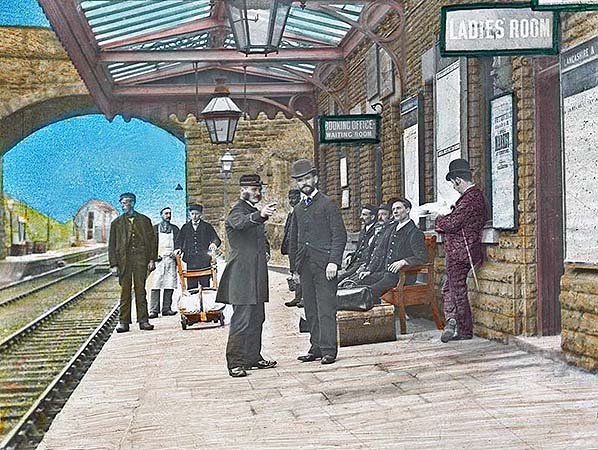 Thongs Bridge station looking south-west c1890 from the up (Huddersfield-bound) platform. The booking office and waiting rooms are in the stone-built single-storey building in the foreground. The men, some of whom appear to be railway staff, are sheltered by the glazed awning from which two splendid hexagonal gas lanterns are suspended. This photograph pre-dates the improvements to Thongs Bridge station which were authorised in 1893, when the original down platform, with minimal facilities - seen beyond Heys Road overbridge – would be abandoned, with its replacement built opposite the up platform, this side of the bridge. At the same time a new booking hall would be built at the far end of the up platform, a little below the level of Heys Road.
Photo from Jim Lake collection  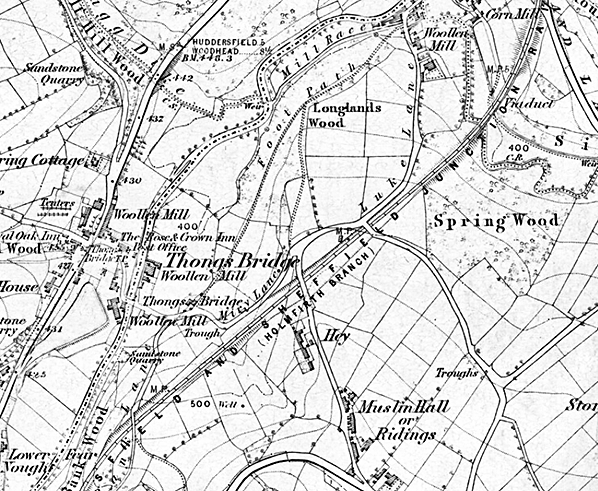 1854 1: 10,560 OS map. The recently-opened Holmfirth Branch is shown, but at Thongs Bridge there is no evidence of a station although it opened with the line in 1850. The survey was 1848 – 1851.
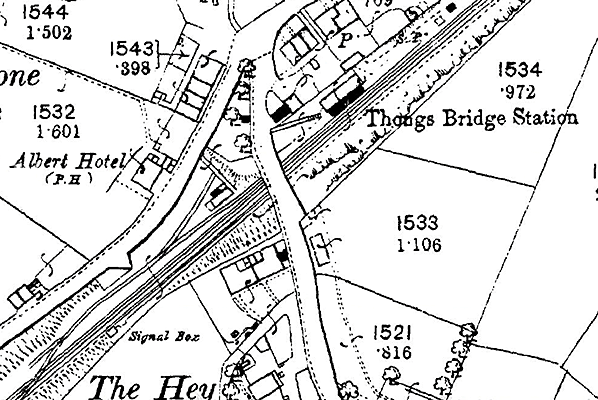 1893 1: 2,500 OS map. The two platforms at Thongs Bridge station are staggered either side of the Heys Road overbridge. The north-west (up) platform is north-east of the bridge with an approach path leading down from the road. The station building with its awning is shown. The south-east (down) platform is devoid of any structures, but the signal box is just beyond the ramp at its south-western end. Access to this platform is via an unmarked barrow crossing from the south-west end of the up platform. The goods facilities are on the opposite side of the running lines to the down platform, including a small building approached by a track off Miry Lane. One siding, entered from the Holmfirth direction, splits into two at its north-east end, and there is a headshunt at the south-west close to the junction with the running lines. The rock-walled cutting is shown clearly between Heys Road and Springwood Road bridges. Two railway cottages (semidetached) are north-east of the station site, on Springwood Road. Some industrial sites are situated west of the station: a size and bone works (probably highly malodorous); Albion woollen mill; and Thongs Bridge woollen mill.
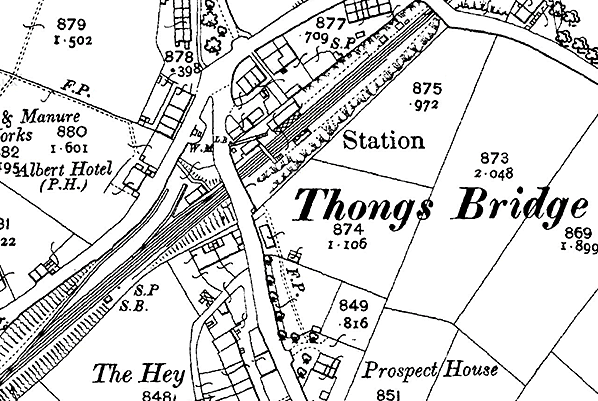
1906 1: 2,500 OS map. Thongs Bridge station has changed substantially since the map of 1893. The original down (south-east) platform has been abandoned and a new one built on the opposite side of Heys Road to face the up platform. The new platform has a small building with an awning, directly opposite the building on the up platform. A footbridge connects the platforms, and it is connected to a booking hall entered from Heys Road. In the goods yard the original siding has been converted into a loop and a further siding has been added at the north-western boundary of the site.
Click here for a larger version. 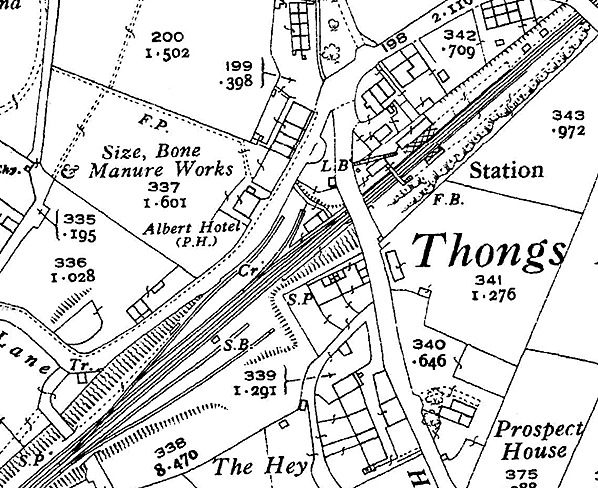 1932 1: 2,500 OS map. The passenger facilities appear unchanged since the map of 1906. The goods facilities have expanded, with two additional sidings on the down side, behind the signal box, and entered from the Holmfirth direction. Click here for a larger version.
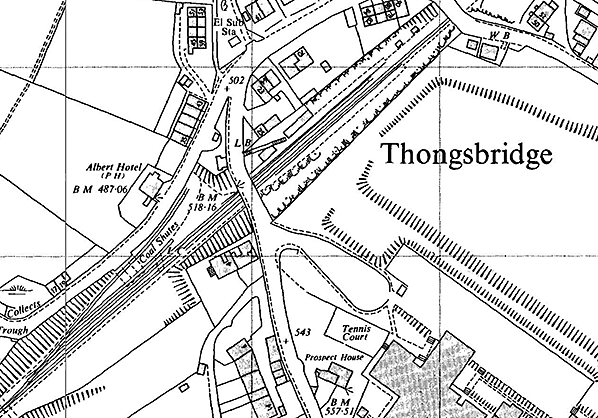 1966 1: 2,500 OS map.Thongs Bridge station has closed to all traffic by this time, the goods facilities having closed in 1965. The station is no longer named, but the goods sidings are shown and ‘Coal Shutes’ are named. The up platform buildings are in place, but the down platform shelter has gone. Track-lifting is in progress, with the up track removed north-eastwards from the adjacent platform. The name of the settlement is shown as a single word, rather than two. Click here for a larger version.
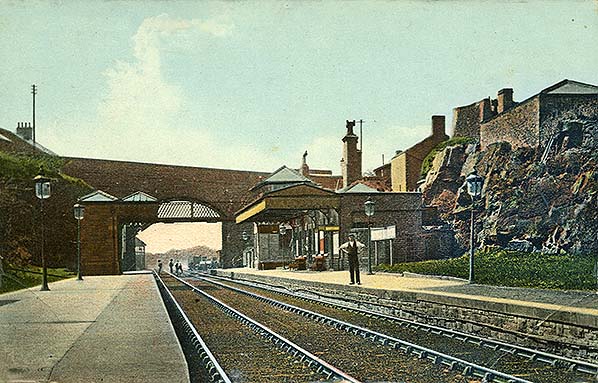 A ‘tinted’ general view of Thongs Bridge looking south-west from the down platform in the early years of the twentieth century. Until the 1890s the platform arrangement was staggered, with the down platform being on the far side of the road bridge seen here and opposite the goods sidings. The main building, on the up platform, is believed to date from the opening of the station in 1850. Built of sandstone and with a hipped roof it carries a hipped awning with a frilly valance. The elevated building beyond it is the booking hall which was added in the 1890s along with the footbridge and the new down platform and its shelter; this building, with its hipped awning, complements its larger neighbour on the opposite platform. The gas lamp glasses are of a style seldom seen in use after the 1920s
Copyright photo from John Alsop collection 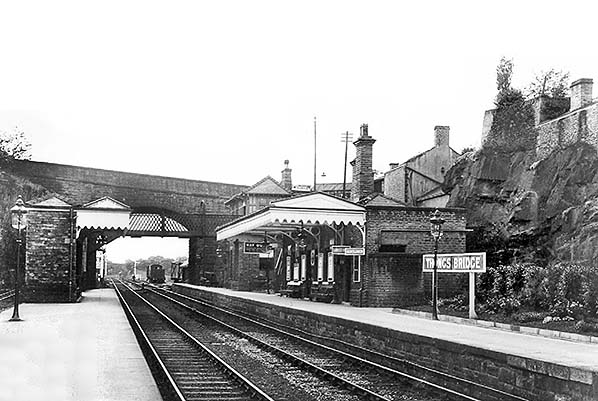 A general view of Thongs Bridge looking south-west from the down platform. Until the 1890s the platform arrangement was staggered, with the down platform being on the far side of the road bridge seen here and opposite the goods sidings. The main building, on the up platform, is believed to date from the opening of the station in 1850. Built of sandstone and with a hipped roof it carries a hipped awning with a frilly valance. The elevated building beyond it is the booking hall which was added in the 1890s along with the footbridge and the new down platform and its shelter; this building, with its hipped awning, complements its larger neighbour on the opposite platform. The gas lamp glasses are of a style seldom seen in use after the 1920s.
Photo from RM Casserley & Alan Young collections 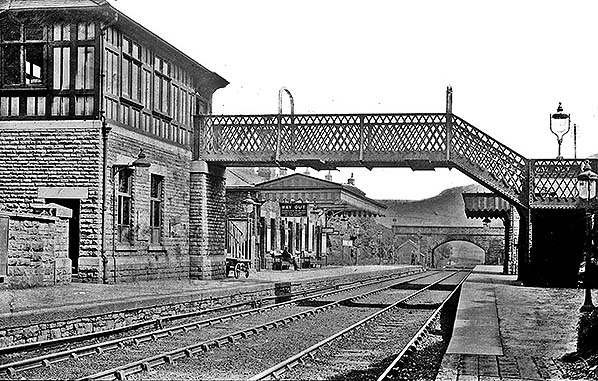
Thongs Bridge station in the early years of the twentieth century, looking north-east from the trackbed close to Heys Road bridge. The elevated building on the left is the booking hall, entered from Heys Road. Passengers descended directly to the up (Huddersfield-bound) platform on the left, or crossed via the footbridge to the down platform for Holmfirth. On the up platform is the original station building with its awning; until the new booking hall was built in the 1890s, the booking facilities were in the platform building, as they would again be in the station’s later years. The down platform, with its waiting shelter and awning, was also built in the 1890s, replacing a platform behind the photographer.
Copyright photo from John Alsop collection
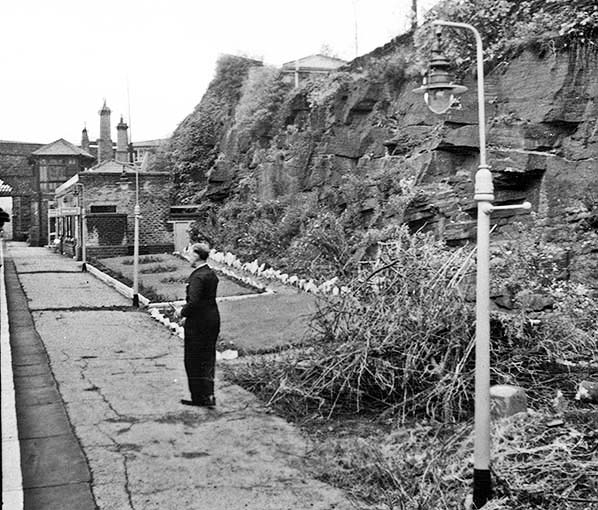
The up (north-west) platform at Thongs Bridge is seen from a passing train on 3 November 1956. In the background are the main building, now shorn of its awning, and the former booking office in its elevated position adjacent to the footbridge. Booking facilities are now provided in the main building on the platform. ‘Sugg’ gas lamps are now seen on the standards. A neat garden extends from the platform to the rock cutting. This station was staffed until it closed.
Photo by J C W Halliday 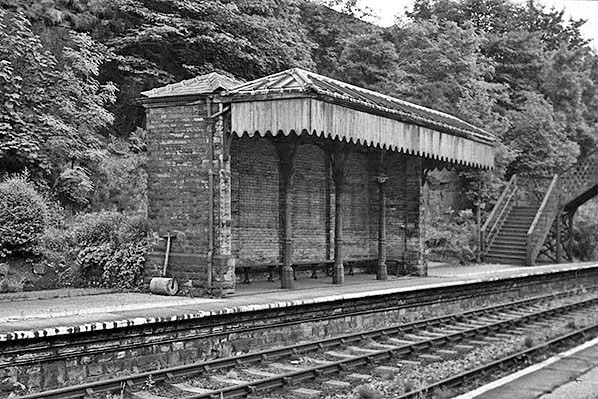 The waiting shelter on the down platform is seen c1950s. The stone construction, hipped roof and hipped awning with its frilly valance give this shelter dignity, and it complements the design of the larger building on the opposite platform. Whilst its larger neighbour lost its awning by the mid 1950s the awning on the shelter was retained until the station closed to passengers. Although the structure is open-fronted, the station was in a deep rock cutting which will have afforded some shelter to waiting passengers. Photo from John Mann collection 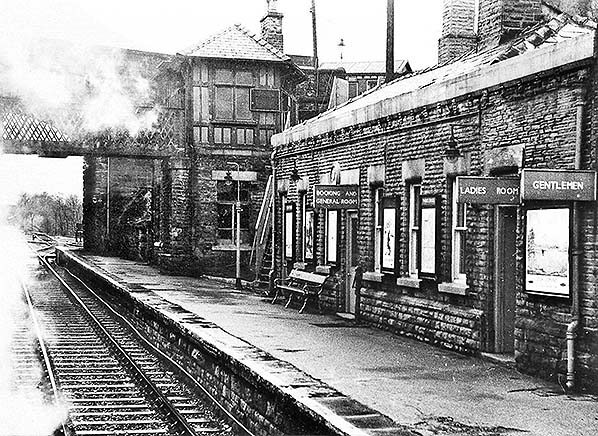 On 15 February 1958 the up platform of Thongs Bridge station is seen from a train, with steam from the loco adding atmosphere. Although it has been stripped of its awning the building on the platform still looks cared-for, with clear signage (probably recently painted in BR[NE] tangerine) and pristine posters on the notice boards; it contains the booking office and ‘general room’ as well as ladies’ and gents’ toilets. The former booking hall is at a higher elevation, governing the access to the footbridge to the down platform and adjoining the steps between the road entrance and the up platform; the booking hall has an interesting non-rectangular shape. The original area of goods sidings can be seen beyond Heys Road overbridge. Photo by J C W Halliday Click here for Thongs Bridge Station Gallery 2:
|
 When the railway arrived, development at Thongs Bridge consisted of a couple of woollen mills within half-a-mile west of the station, and a scattering of cottages near the mills and to the south of the station along Heys Road. A rock cutting of substantial proportions was required to enable the railway to pass through a spur of high ground, and the up (north-west) platform was placed within it, north-east of the Heys Road bridge. It was provided with a single-storey stone building with a hipped roof and tall chimneys. A hipped awning with a serrated valance sheltered the platform in front of the building. The long and narrow down platform was on the opposite side of Heys Road, reached by a sleeper-built barrow crossing from the south-west end of the up platform. The signal box was added in 1880, installed by the Gloucester Wagon Co; it stood just beyond the south-western ramp of the down platform. Goods facilities were located on the up side, facing the down platform.
When the railway arrived, development at Thongs Bridge consisted of a couple of woollen mills within half-a-mile west of the station, and a scattering of cottages near the mills and to the south of the station along Heys Road. A rock cutting of substantial proportions was required to enable the railway to pass through a spur of high ground, and the up (north-west) platform was placed within it, north-east of the Heys Road bridge. It was provided with a single-storey stone building with a hipped roof and tall chimneys. A hipped awning with a serrated valance sheltered the platform in front of the building. The long and narrow down platform was on the opposite side of Heys Road, reached by a sleeper-built barrow crossing from the south-west end of the up platform. The signal box was added in 1880, installed by the Gloucester Wagon Co; it stood just beyond the south-western ramp of the down platform. Goods facilities were located on the up side, facing the down platform.  The layout of the passenger facilities at Thongs Bridge proved unsatisfactory, twice drawing criticism from the Board of Trade following accidents to passengers using the station. Consequently in 1893 the LYR made arrangements with Robert Leake & Co to build a new down platform beyond Heys Road bridge, opposite the up platform, and to widen the gap between the running lines from 5ft 9in to the standard 6ft 0in. Also included in the new works were a new booking office on the up side, -entered from Heys Road overbridge, which gave access both to a diagonally-placed staircase down to the platform - and the iron-lattice footbridge across the two railway tracks to the new down platform. The up platform was heightened as part of the improvements. A rather attractive stone-built open shelter was provided on the new down platform, its hipped roof and hipped awning complementing the structures on the up platform. At the same time the goods facilities were improved, with sidings being added on the down side, behind the signal box. A 3-ton yard crane was installed. Because the goods facilities were now on both sides of the running lines, a cart way was built to link the two sides. The crossing was protected by a lifting barrier, worked from the signal box and interlocked with signals for the running lines. The principal traffic handled in the goods yard was coal and the woollen goods produced in the nearby Thongs Bridge and Albion mills.
The layout of the passenger facilities at Thongs Bridge proved unsatisfactory, twice drawing criticism from the Board of Trade following accidents to passengers using the station. Consequently in 1893 the LYR made arrangements with Robert Leake & Co to build a new down platform beyond Heys Road bridge, opposite the up platform, and to widen the gap between the running lines from 5ft 9in to the standard 6ft 0in. Also included in the new works were a new booking office on the up side, -entered from Heys Road overbridge, which gave access both to a diagonally-placed staircase down to the platform - and the iron-lattice footbridge across the two railway tracks to the new down platform. The up platform was heightened as part of the improvements. A rather attractive stone-built open shelter was provided on the new down platform, its hipped roof and hipped awning complementing the structures on the up platform. At the same time the goods facilities were improved, with sidings being added on the down side, behind the signal box. A 3-ton yard crane was installed. Because the goods facilities were now on both sides of the running lines, a cart way was built to link the two sides. The crossing was protected by a lifting barrier, worked from the signal box and interlocked with signals for the running lines. The principal traffic handled in the goods yard was coal and the woollen goods produced in the nearby Thongs Bridge and Albion mills.
 In August 1959 the proposal to close the Holmfirth Branch to passengers was announced. Ironically, only a few months earlier the 450-pupil Holmfirth Secondary Modern school had opened in January 1959 at Thongs Bridge, a couple of minutes’ walk from the station, and by 1961 the school roll was to rise to 1,000. This would undoubtedly have contributed a healthy amount of passenger traffic, but the closure went ahead on 2 November 1959. In the final timetable (summer 1959) up trains called at Thongs Bridge at 7.15am (Saturday excepted), 8.30am, 1.38pm (Saturday only) and 5.07pm. Trains left for Holmfirth at 7.57am, 12.59pm (Saturday only), 4.24pm and 5.43pm. The BR(NE) passenger timetable book effective from 2 November 1959 erroneously showed Thongs Bridge and Holmfirth stations as open, now served by diesel trains!
In August 1959 the proposal to close the Holmfirth Branch to passengers was announced. Ironically, only a few months earlier the 450-pupil Holmfirth Secondary Modern school had opened in January 1959 at Thongs Bridge, a couple of minutes’ walk from the station, and by 1961 the school roll was to rise to 1,000. This would undoubtedly have contributed a healthy amount of passenger traffic, but the closure went ahead on 2 November 1959. In the final timetable (summer 1959) up trains called at Thongs Bridge at 7.15am (Saturday excepted), 8.30am, 1.38pm (Saturday only) and 5.07pm. Trains left for Holmfirth at 7.57am, 12.59pm (Saturday only), 4.24pm and 5.43pm. The BR(NE) passenger timetable book effective from 2 November 1959 erroneously showed Thongs Bridge and Holmfirth stations as open, now served by diesel trains!
 Home Page
Home Page